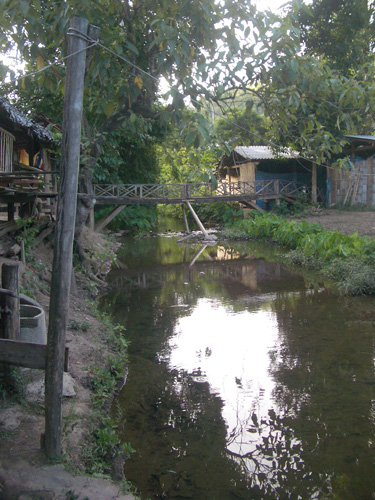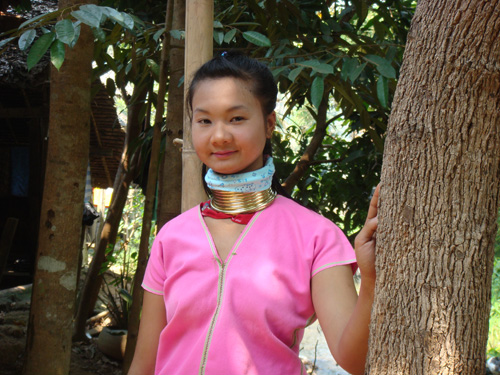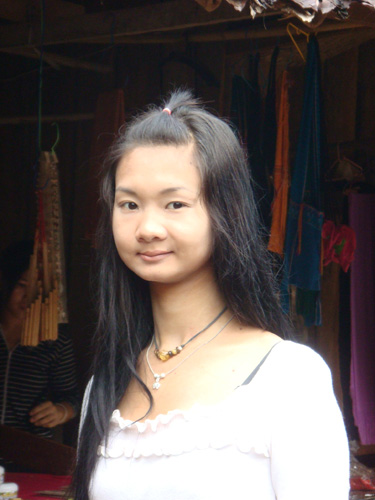การสำรวจภาคสนาม
Field Surveys and Research Sites
- อ.สวนผึ้ง จ.ราชบุรี
Amphoe Suan Phueng, Ratchaburi- สวนผึ้ง
Amphoe Suan Phueng- โครงการในพระราชดำริ
Projects of H.R.H. Princess Maha Chakri Sirindhorn's Initiative - ศูนย์อพยพ
Refugee Centre - งานประเพณีกินข้าวห่อ
The Karen's Wrapped Rice Feast - สภาพบ้านสวนผึ้ง
Ban Suan Phueng
- โครงการในพระราชดำริ
- แก่งส้มแมว
Kaeng Som Maeo - ชาวกะเหรี่ยงปลูกหญ้าแฝก
The Karen Growing Vetiver Grass - บ้านท่ามะขาม
Ban Tha Makham - บ้านบ่อหวี
Ban Bo Wi - บ้านพุระกำ
Ban Phu Rakam - สุดชายแดนตะวันตก จ.ราชบุรี
The Westernmost Border in Ratchaburi
- สวนผึ้ง
- อ.ด่านช้าง จ.สุพรรณบุรี และ อ.บ้านไร่ จ.อุทัยธานี
Amphoe Dan Chang, Suphan Buri and Amphoe Ban Rai, Uthai Thani - บ้านห้วยเสือเฒ่า อ.เมือง จ.แม่ฮ่องสอน
Ban Huai Suea Thao, Amphoe Mueang, Mae Hong Son - บ้านห้วยปูแกง อ.เมือง จ.แม่ฮ่องสอน
Ban Huai Pu Kaeng, Amphoe Mueang, Mae Hong Son - บ้านห้วยขาน อ.เมือง จ.แม่ฮ่องสอน
Ban Huai Khan, Amphoe Mueang, Mae Hong Son - บ้านดงดำ อ.ลี้ จ.ลำพูน
Ban Dong Dam, Amphoe Li, Lamphun - บ้านห้วยต้ม อ.ลี้ จ.ลำพูน
Ban Huai Tom, Amphoe Li, Lamphun- ห้วยต้มวันพระ
Buddhist Sabbath Day - ห้วยต้มวันงาน
Ceremonies and Festivals - วีดิทัศน์
Video
- ห้วยต้มวันพระ
- บ้านน้ำบ่อน้อย อ.ลี้ จ.ลำพูน
Ban Nam Bo Noi, Amphoe Li, Lamphun - อ.ท่าสองยาง อ.อุ้มผาง อ.แม่ระมาด อ.แม่สอด จ.ตาก
Amphoe Tha Song Yang, Amphoe Um Phang, Amphoe Mae Ramat and Amphoe Mae Sot, Tak - อ. หัวหิน จ. ประจวบคีรีขันธ์
Amphoe Hua Hin, Prachuap Khiri Khan - อำเภอบ้านไร่ จังหวัดอุทัยธานี
Amphoe Banrai, Changwat Uthai Thani
บ้านห้วยเสือเฒ่า ตำบลผาบ่อง อำเภอเมือง จังหวัดแม่ฮ่องสอน
Ban Huai Suea Thao, Tambon Pha Bong, Amphoe Mueang, Mae Hong Son



วิวแม่ฮ่องสอน ถ่ายจากเครื่องบิน
The scenery of Mae Hong Son taken from the plane

ทางเข้าบ้านห้วยเสือเฒ่าต้องผ่านลำน้ำแบบนี้ประมาณ 11 แห่ง จึงจะถึงหมู่บ้าน
The road, with about 11 puddles, before reaching Ban Huai Suea Thao

ภาพที่เห็นเมื่อมาถึงหมู่บ้าน
A picture of the village upon arrival

เสาทีที่ตั้งขึ้นในวันสงกรานต์ของชาวกะยา (กะเหรี่ยงแดง) ประชากรส่วนใหญ่ของบ้านห้วยเสือเฒ่า
The Tee poles erected by the Kayah(the Red Karen), the majority population of Ban Huai Suea Thao, in celebration of the Songkran Festival

เสาทีของชาวกะยั้ง (กะเหรี่ยงคอยาว) ในเขตชุมชนกะยั้ง ซึ่งเป็นส่วนหนึ่งของบ้านห้วยเสือเฒ่า
The Tee poles of the Kayan (the Long-Necked Karen) in the Kayan Community, which is part of Ban Huai Suea Thao

ลองเดินไปโรงเรียนแบบพวกเด็ก ๆ
Walking to school like small children

โรงเรียนบ้านห้วยเสือเฒ่า บรรยากาศไม่แพ้โรงเรียนในเมือง
The atmosphere of Ban Huai Suea Thao School that is compatible with schools in the town

ยามเย็นหลังเก็บข้อมูลเสร็จ ไปเดินเล่นท้ายหมู่บ้าน
Going for a late afternoon walk to the end of the village after finishing collecting information

เด็ก ๆ มายืนดูเราตอนเดินเล่นท้ายหมู่บ้าน เราก็เลยถ่ายรูปเด็ก ๆ ไว้ดูเล่นเช่นกัน
Children coming to watch us going for a walk to the end of the village and our taking their pictures as keepsakes

บ้านไม้ปนตึกของผู้มีฐานะจะอยู่บริเวณหัวบ้าน บ้านฝาขัดแตะใต้ถุนสูงมุงใบตองตึงจะอยู่ท้ายบ้าน ถ้าอยากเห็นต้องเดินไกลหน่อย
Wood-bricked houses of well-to-do people located at the entrance of the village; houses made of woven bamboo strips with their roofs made of leaves and a tall space under the house, located at the far end of the village. It is quite a walk to get to see them.

บริเวณย่านกลาง (ศูนย์การค้า) ของชุมชนกะเหรี่ยงบ้านห้วยเสือเฒ่า
The centre of trade (shopping centre) of the Karen Community in Ban Huai Suea Thao

ทางเข้าสู่เขตร้านค้าของคนม้งที่ผู้มาเยือนต้องเดินผ่านก่อนเข้าไปเยี่ยมชาวกะยั้ง (กะเหรี่ยงคอยาว)
Visitors having to pass Hmong shops before visiting the Kayan (the Long-Necked Karen)

ไม้แกะสลักสาวพนักงานต้อนรับ เธอสามารถหันหน้ามาสวัสดีเราได้ (ถ้าตอนกลางคืนมีคนแอบมาปรับให้หน้าตรงเป็นหน้าเอียง)
Wooden sculptures depicting the Kayan reception committee, turning their faces to greet us (At night, their faces are turned sideways by unknown perpetrators)

ลำห้วยเล็ก ๆ กั้นเขตแดนของคนกะยั้ง (กะเหรี่ยงคอยาว) ซึ่งส่วนใหญ่เป็นกะเหรี่ยงพุทธ
A small stream serving as the border of the land of the Kayan (the Long-Necked Karen), who are mostly Buddhists.


จากร้านค้าของคนม้ง เดินข้ามสะพานก็ถึงเขตชุมชนคนกะยั้ง นักท่องเที่ยวชาวต่างประเทศต้องเสีย 50 บาท เป็นค่าผ่านทาง
Crossing the bridge from the Hmong shops to the Kayan Community, requiring a 50 Baht fee from foreign visitors

บรรยากาศภายในชุมชนคนกะยั้งหรือกะเหรี่ยงคอยาวซึ่งนักท่องเที่ยวชาวไทยและชาวต่างประเทศพากันมาชม
The atmosphere of the Kayan (the Long-Necked Karen) Community, visited by Thai and foreign tourists


สาวน้อยมะนัง เดือนมีนาคม 2552 เธอใส่ห่วงคอทองเหลือง เดือนพฤษภาคม 2552 เธอถอดห่วงคอเสียแล้ว สิ้นสุดกันทีสำหรับหน้าที่ต้อนรับและขายของให้นักท่องเที่ยว อิสรภาพและแฟชั่นคนเมืองที่เธอโหยหา
Manang wearing brass coils in March, 2009 and taking them off in May, 2009, marking the end of her duty of taking care of tourists and selling things to them. She can now enjoy liberty and the fashion of the town's people that she has longed for.

หญิงกะยั้งรุ่นอายุใกล้ 60 ปี
A Kayan woman of approximately 60 years old

มะจะ มะแว มะดัง (จากซ้ายไปขวา) สาวกะยั้งวัย 25-26 ปี ทุกคนแต่งงานและมีลูกแล้ว สดชื่นแจ่มใสเตรียมต้อนรับนักท่องเที่ยว
(From left to right) Macha, Mawae and Madang, aged 25-26, married and with children, in joyful spirits while getting ready to welcome tourists

มะแว ผู้สามารถพูดได้หลายภาษา กิจการขายของที่ระลึกให้นักเที่ยวจึงรุ่งเรือง วันนี้แต่งแก้มด้วยแป้งพม่าเป็นรูปใบไม้เพื่อเตรียมต้อนรับผู้มาเยือน
Mawae, a multi-lingual Karen who has profited from selling souvenirs to tourists, painting leaves on her cheeks with Burmese powder in preparation for a visit by tourists




หญิงกะยา (กะเหรี่ยงแดง) ในชุดประจำเผ่าสีสดใส
Kayah women (the Red Karen) in their colourful tribal costume

เล่นพิณและกีตาร์ประกอบการร้องเพลงที่มีเนื้อเพลงเป็นภาษากะยั้ง แต่มีท่วงทำนองเป็นเพลงสากล ของแถมสำหรับผู้ซื้อแผ่นซีดีเพลงหรือของที่ระลึกอื่น ๆ
Playing the lyre and the guitar in accompaniment to singing; the songs being in the Kayan language but the tune international—a free gift for those who have a purchase, CD or other souvenirs

สาวกะยั้งนั่งปั่นด้ายยามว่างเว้นนักท่องเที่ยว
A young Kayan woman spinning thread during the break from tourists


เด็กน้อยชาวกะยอ (กะเหรี่ยงหูใหญ่) ในชุดประจำเผ่า ตัวแค่นี้ก็ขายของให้นักท่องเที่ยวได้แล้ว (โปรดสังเกตขนาดของตุ้มหู)
Young Kayaw girls (Large Ear-Lobed Karen) in their traditional attire, no matter how small they are selling souvenirs to tourists (Notice the size of their earrings.)

ร้านขายของคนกะยอ ชุมชนกะยอที่บ้านห้วยเสือเฒ่าอยู่ในเขตเดียวกันกับชุมชนกะยั้ง
A shop owned by a Kayaw in the Kayaw Community in Ban Huai Suea Thao, located in the same area as the Kayan Community


เตรียมเส้นด้ายไว้ทอผ้าฝ้ายเพื่อนำมาทำเป็นของใช้ เช่น เสื้อ ผ้าพันคอ ถุงย่าม ฯลฯ
Preparing thread to weave into cloth to make clothes, scarves and satchels


ทอผ้าพลางคุยพลาง ยามว่างจากการขายของที่ระลึกให้นักท่องเที่ยว ภาพชินตาเห็นได้ทั่วไปในชุมชนกะยั้ง (กะเหรี่ยงคอยาว)
Talking while weaving after being freed from selling souvenirs to tourists—a familiar sight in the Kayan (the Long-Necked Karen) Community.

นวัตกรรม "รถทอผ้า" สิ่งประดิษฐ์ที่สามีช่วยคิดค้นเพื่อช่วยลดความเมื่อยล้าให้ภรรยาผู้เป็นโรคปวดเข่า
An innovation, "a weaving machine fixed with wheels," made by a husband who has tried to alleviate the wife's pain in the knees



บรรยากาศคึกคักเมื่อมีผู้มาเยือนหลากหลายเชื้อชาติและหลากหลายวัตถุประสงค์
Visitors of different races and for different purposes enlivening the atmosphere of the village

สาวกะยั้งในชุดออกกำลังกาย ยามเย็นเมื่อเสร็จสิ้นภารกิจต้อนรับนักท่องเที่ยว
The young Kayan women in their exercise outfits in the evening after taking care of tourists

เสมือน "พระธาตุดอยกองมู" แห่งบ้านห้วยเสือเฒ่าของชาวกะยา (กะเหรี่ยงแดง)
A replica of "the Phra That Doi Kong Mu" in the Kayah's (the Red Karen) Ban Huai Suea Thao

ช่วยกันทำกระทงใบตองสำหรับใส่อาหารถวายพระพุทธและเซ่นไหว้ (ก่อนวันพระ)
Making banana leaf containers for offerings to the Lord Buddha's statue and spirits before a Buddhist Sabbath Day

กระทงอาหารสำหรับถวายพระพุทธ
Banana leaf containers and food alms offerings for the Lord Buddha's statue


จุดธูปจุดเทียนและถวายอาหารแด่พระพุทธ (เช้ามืดวันพระ)
Lighting candles and jos sticks and offering food alms in banana leaf containers to the Lord Buddha statue (at the crack of dawn on a Buddhist Sabbath Day)


เซ่นไหว้ผีตรงทางแยก หลังถวายอาหารพระพุทธ (เช้าวันพระ)
Giving offerings to the spirits at the intersections after presenting food alms to the Lord Buddha statue (On the morning of a Sabbath Day)

จุดธูปเทียนสักการะพระภูมิเจ้าที่ในเขตเรือนตน (คืนวันพระ)
Lighting jos sticks and candles to pay homage to the House Guardian Spirit on the night of a Buddhist Sabbath Day

จุดธูปเทียนสักการะสิ่งศักดิ์สิทธิ์ที่ศาลเจ้าบ้านเจ้าเมืองในคืนวันพระ
Lighting jostled sticks and candles as homage to the Sacred Entity at the Community Shrine on the night of a Sabbath day


ประเพณีพิธีกรรมเมื่อสร้างบ้านใหม่
A ritual performed when building a new house

กรงนอนของแม่ไก่และลูกไก่ สานด้วยไม้ไผ่
Chicken coops made of woven bamboo strips

อุปกรณ์ตำข้าวและฝัดข้าวที่ใช้ในชีวิตประจำวัน
Rice pounding/grinding and sifting utensils used in daily life

ครัวไฟหุงหาอาหารของคนกะยา (กะเหรี่ยงแดง)
A kitchen of the Kayah (the Red Karen)

แกงกะยั้ง (กะเหรี่ยงคอยาว)
A Kayan (Long-Necked Karen) curry

แม่และลูกซ้อนรถมอเตอร์ไซค์แบบห้าชั้น
A mother and four children making five passengers on a motorcycle

คุณพ่อ (หัวหน้าชุมชนกะยั้ง) กำลังจะพาลูกไปโรงเรียน ซ้อนรถมอเตอร์ไซค์แบบหลังชนกัน
A father, the leader of the Kayan Community, taking his children, who are sitting back to back, to school by a motorcycle

ครอบครัวน่ารัก หนุ่มสาวชาวกะยั้งกับลูกสาววัย 8 เดือน
A lovely Kayan family consisting of young parents and an 8 month old daughter


คุณแม่กะยั้ง (กะเหรี่ยงคอยาว) แสนสวยกับลูกสาวน่ารักที่ไม่อายกล้อง
A beautiful Kayan (the Long-Necked Karen) mother and her lovely daughter, posing for the camera

มะดัง (ซ้าย) กับมะแว (ขวา) ช่วยกันสอนให้ลูกสาวมะดังตั้งไข่
Madang (left) and Mawae (right) teaching Madang's daughter to stand up

มะแว (ภรรยาหัวหน้าชุมชนกะยั้ง) กับลูกคนที่ 3
Mawae, a wife of the Kayang Community's leader, and her third child

เด็กเล็กหรือเด็กอนุบาลกำลังรับประทานอาหารกลางวันที่โรงเรียน
Kindergarten children having lunch at school


เพื่อนคู่หู อุ๊โตะ (ซ้าย) ไล (ขวา) ยิ้มกว้างก่อนพากันออกไปเล่นซนตามประสาเด็ก
The buddies, Uto (left) and Lai (right), smiling broadly before going out to play like other children

ทุกวันพุธ เด็กประถมแต่งชุดลูกเสือและเนตรนารี
On Wednesdays, elementary school children wearing scout and girl scout uniforms



ทุกวันศุกร์ เด็ก ๆ ไปโรงเรียนในชุดประจำเผ่าหรือชาติพันธุ์
On Fridays, children going to school in their traditional or tribal attire

เล่นตามประสาเด็กผู้ชาย เด็กโตช่วยกันจับปลาในห้วย เด็กเล็กเรียนรู้วิธีการจากพี่ ๆ
Boys at play—bigger boys catching fish in the stream and younger ones learning from the seniors



ช้าง แพะ และหมู สัตว์เศรษฐกิจของคนกะเหรี่ยงบ้านห้วยเสือเฒ่า
Elephants, goats and pigs—animals that can make a profit for the Karen in Ban Haui Suea Thao



ไก่และเป็ด สัตว์เลี้ยงของทุกครัวเรือน ไข่และเนื้อใช้ประกอบอาหารในโอกาสพิเศษ
Poultry in every household; eggs and meat for cooking on special occasions

เด็กและสุนัขมักเป็นเพื่อนที่ดีต่อกันไม่ว่ากลุ่มชาติพันธุ์ใด
Friendship between children and dogs, no matter what ethnic group they are

บันทึกเสียงผู้บอกภาษากะยั้งเข้าเครื่องคอมพิวเตอร์แบบพกพาเพื่อวิเคราะห์ลักษณะทางกลสัทศาสตร์ของเสียงพูด
Recording the voice of a Kayan informant on a laptop computer for an analysis of the phonetic characteristics of Kayan speech

หัวหน้าโครงการกำลังเก็บข้อมูลกับคนกะยอ (กะเหรี่ยงหูใหญ่) เพื่อวิเคราะห์คำลักษณนามในภาษากะเหรี่ยงทั้ง 6 กลุ่ม ที่บ้านผู้ใหญ่บ้านที่เป็นคนกะยา (กะเหรี่ยงแดง)
The Chairman of the research team interviewing the Kayaw (the Large Ear-Lobed Karen) to analyze classifications in the language of the six groups of the Karen at the house of a Village Headsman, who is a Kayah (the Red Karen)

เดินทางขึ้นเขาไปตามถนนลูกรังจากบ้านห้วยเสือเฒ่าประมาณ 10 ก.ม. ก็ถึงบ้านแม่ส่วยอู บ้านกะยาตั้งใหม่ จัดตั้งขึ้นเพื่อเป็นหมู่บ้านยามชายแดน มีค่ายทหารช่วยปกป้องและดูแลความปลอดภัย มีการส่งเสริมอาชีพทอผ้าพื้นเมือง จักสาน และทำเครื่องเงิน ตามพระราชดำริสมเด็จพระนางเจ้าฯ พระบรมราชินีนาถ
Driving along the laterite road from Ban Huai Suea Thao for approximately 10 kilometres, the research team arrived at Ban Mae Suai U, which was founded to serve as a "security guard" village on the borders. Its security and safety are the responsibility of a military base. The promotion of weaving local cloth, basketry and making silverware is on Her Majesty the Queen's initiative.

คณะฝึกวิจัยภาคสนามทางภาษาศาสตร์จากภาควิชาภาษาศาสตร์ คณะอักษรศาสตร์ จุฬาฯ ไปสำรวจภาษากะเหรี่ยงที่บ้านแม่ส่วยอู
The Linguistic Field Research Team from the Department of Linguistics of the Faculty of Arts, Chulalongkorn University conducting a Karen language survey in Ban Mae Suai U


